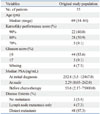Abstract
Purpose
Materials and Methods
Results
Figures and Tables
 | Fig. 1Schematic graph of PSA doubling times according to different intervals during the transient period from the diagnosis of CRPC until the end of anti-androgen withdrawal and PSA response during docetaxel chemotherapy. PSA, prostate-specific antigen; PSADT1, PSA doubling time calculated with the traditional interval from the first rise greater than the nadir during androgen deprivation therapy until androgen withdrawal; PSADT2, PSA doubling time from the initial rise after anti-androgen withdrawal until the start of chemotherapy; PSADT3, PSA doubling time during the total interval from the nadir until the start of chemotherapy. |
Table 1
Baseline Patient Characteristics

Table 2
Pretreatment PSA Doubling Time Values Using Different Intervals in the Calculation and Ratio of PSA Doubling Times

| Variables | Mean | SD | Median | Range |
|---|---|---|---|---|
| PSADT1 (mons) | 3.61 | 4.62 | 2.37 | 0.25-27.58 |
| PSADT2 (mons) | 2.42 | 2.13 | 1.76 | 0.06-12.46 |
| PSADT3 (mons) | 3.11 | 1.99 | 2.51 | 0.25-9.29 |
| PSADT2/PSADT1 | 1.18 | 1.32 | 0.75 | 0.01-6.70 |
PSA doubling time was calculated using the log slope method.14 Briefly, the PSA rate variable was calculated by taking the natural log of each PSA measurement, plotting them versus time and then measuring the slope of the linear regression through the data points ln [PSAt]=ln [PSAinitial]+mt (t=time). PSADT was then calculated by dividing ln 2 by m.14 PSADT1, PSA doubling time calculated using the conventional interval from the first rise greater than the nadir during androgen deprivation therapy until the start of the next treatment; PSADT2, PSA doubling time calculated using the period from the initial rise after anti-androgen withdrawal until the start of chemotherapy; PSADT3, PSA doubling time calculated using the total period from the first rise greater than the nadir during androgen deprivation therapy until the start of chemotherapy; PSADT2/PSADT1, the ratio of PSADT2 to PSADT1; SD, standard deviation; PSA, prostate-specific antigen.
Table 3
Univariate Analyses of Pretreatment Binomial Variables for Occurrences of PSA Flare during Chemotherapy in Patients with CRPC

Table 4
Univariate Logistic Regression Analyses of Pretreatment Continuous Variables for Occurrences of PSA Flare during Chemotherapy in Patients with CRPC

PSA, prostate-specific antigen; CRPC, castration-resistant prostate cancer; CI, confidence interval; PSADT1, PSA doubling time calculated using the conventional interval from the first rise greater than the nadir during androgen deprivation therapy until the start of the next treatment; PSADT2, PSA doubling time calculated using the period from the initial rise after anti-androgen withdrawal until the start of chemotherapy; PSADT3, PSA doubling time calculated using the total period from the first rise greater than the nadir during androgen deprivation therapy until the start of chemotherapy; ratio of PSA doubling time, PSADT2/PSADT1.
Table 5
Multivariate Logistic Regression Analysis for Occurrences of PSA Flare during Chemotherapy in Patients with CRPC

PSA, prostate-specific antigen; CRPC, castration-resistant prostate cancer; CI, confidence interval; PSADT1, PSA doubling time calculated using the conventional interval from the first rise greater than the nadir during androgen deprivation therapy until the start of the next treatment; PSADT2, PSA doubling time calculated using the period from the initial rise after anti-androgen withdrawal until the start of chemotherapy; ratio of PSA doubling time, PSADT2/PSADT1.




 PDF
PDF ePub
ePub Citation
Citation Print
Print


 XML Download
XML Download